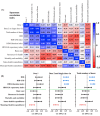Vaccination Coverage Against Coronavirus Disease 2019 in People Living on Quilombos in Brazil and Its Association With the Human Development Index and the Quality of the Health System
- PMID: 40762247
- PMCID: PMC12322944
- DOI: 10.1002/jmv.70533
Vaccination Coverage Against Coronavirus Disease 2019 in People Living on Quilombos in Brazil and Its Association With the Human Development Index and the Quality of the Health System
Abstract
Since the slavery period in Brazil, the Quilombola population has faced problems related to social vulnerability and poor health. The coronavirus disease (COVID)-19 pandemic has made this social inequality more evident, and the postpandemic scenario has proved even more challenging with the difficult access to basic living conditions, including low vaccination coverage. In view of this, this study aims to present the epidemiological profile of vaccination against COVID-19 in the population living in quilombos in Brazil. An observational study was carried out using information from the National Health Data Network provided by the Brazilian Ministry of Health. Vaccination coverage was correlated with the human development index (HDI) and health quality indicators. In the Quilombola population, a total of 1 848 494 doses of vaccines were administered, mostly related to the first dose (45.43%) and the second or single-dose vaccine vials (42.17%), representing a vaccination coverage of 48.43% and 49.41%, respectively; in addition, a total of 159.26 doses were administered per 100 inhabitants. There was an imbalance in the vaccination coverage rate and the number of doses administered in relation to the macroregions of Brazil and the Federative Units. In terms of doses administered by age group, the highest concentration was observed among individuals aged 20-59, with over 100 000 doses administered within each group. In the Spearman correlation, the following coefficients were significant: (a) first dose with municipal health spending [CC = -0.57]; (b) second dose or single-dose vaccine vial with HDI [CC = 0.58], HDI-income [CC = 0.58], HDI-education [CC = 0.65], and municipal health spending [CC = -0.61]; and (c) the total number of doses with HDI [CC = 0.58], HDI-income [CC = 0.56], HDI-education [CC = 0.67], and municipal health spending [CC = -0.55]. The epidemiological profile of vaccination against COVID-19 in the Quilombola population in Brazil was associated with a wide variability in relation to macroregions and Federative Units, with few Federative Units vaccinating more than 50% of Quilombola individuals. Among the markers evaluated, the best HDI and the best quality of health services were associated with better vaccination coverage for the first dose, second dose, single-dose vaccine vial, and total number of doses administered in the Quilombola population, demonstrating that there is a relation between social and economic characteristics and the management of vaccines with a potential influence on the outcomes associated with the COVID-19 pandemic.
Keywords: SARS‐CoV‐2; epidemiology; pandemic; public health; quilombo; vaccine; vulnerable population.
© 2025 The Author(s). Journal of Medical Virology published by Wiley Periodicals LLC.
Conflict of interest statement
The authors declare no conflicts of interest.
Figures







Similar articles
-
Global, regional, and national trends in routine childhood vaccination coverage from 1980 to 2023 with forecasts to 2030: a systematic analysis for the Global Burden of Disease Study 2023.Lancet. 2025 Jul 19;406(10500):235-260. doi: 10.1016/S0140-6736(25)01037-2. Epub 2025 Jun 24. Lancet. 2025. PMID: 40578370 Free PMC article.
-
Risk of myocarditis and pericarditis after a COVID-19 mRNA vaccine booster and after COVID-19 in those with and without prior SARS-CoV-2 infection: A self-controlled case series analysis in England.PLoS Med. 2023 Jun 7;20(6):e1004245. doi: 10.1371/journal.pmed.1004245. eCollection 2023 Jun. PLoS Med. 2023. PMID: 37285378 Free PMC article.
-
Antibody tests for identification of current and past infection with SARS-CoV-2.Cochrane Database Syst Rev. 2022 Nov 17;11(11):CD013652. doi: 10.1002/14651858.CD013652.pub2. Cochrane Database Syst Rev. 2022. PMID: 36394900 Free PMC article.
-
Sociodemographic Inequalities in COVID-19 Booster Dose Vaccination Coverage: a Retrospective Study of 196 Provinces in Peru.J Racial Ethn Health Disparities. 2025 Aug;12(4):2399-2408. doi: 10.1007/s40615-024-02060-7. Epub 2024 Jun 24. J Racial Ethn Health Disparities. 2025. PMID: 38914811
-
[Volume and health outcomes: evidence from systematic reviews and from evaluation of Italian hospital data].Epidemiol Prev. 2013 Mar-Jun;37(2-3 Suppl 2):1-100. Epidemiol Prev. 2013. PMID: 23851286 Italian.
References
-
- Polidoro M., de Assis Mendonça F., Meneghel S. N., et al., “Territories Under Siege: Risks of the Decimation of Indigenous and Quilombolas Peoples in the Context of COVID‐19 in South Brazil,” Journal of Racial and Ethnic Health Disparities 8 (2021): 1119–1129, 10.1007/s40615-020-00868-7. - DOI - PMC - PubMed
-
- Ribeiro B. C., Garcia C. G. R., Lima L. J. P., Guerreiro J. F., Póvoa M. M., and Cunha M. G., “Malaria in a Vulnerable Population Living in Quilombo Remnant Communities in the Brazilian Amazon: A Cross‐Sectional Study From 2005‐2020,” Revista do Instituto de Medicina Tropical de São Paulo 66 (2024): e25, 10.1590/S1678-9946202466025. - DOI - PMC - PubMed
Publication types
MeSH terms
Substances
LinkOut - more resources
Full Text Sources
Medical
Miscellaneous

